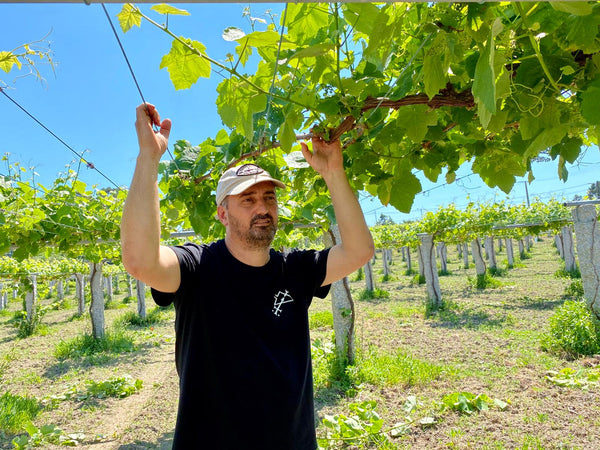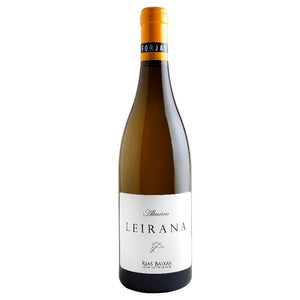
Forjas del Salnés
For years, Rodrigo Méndez's family has cultivated grapes on the Atlantic coast in the village of Meaño, in the heart of the Salnés region. Although Rías Baixas is especially known for its white wines, it was Rodri's dream to produce red wines. Atlantic red wines are not the wine style most sought after by the international wine audience, but the locals have always enjoyed them. However, the growing demand for Albariño has caused many winegrowers to graft Albariño onto their old red vines, as a result of which the areas under cultivation for the red varieties have shrunk to a minimum and some of the historical varieties have almost been lost. Red varieties yield significantly less than Albariño and are more difficult to grow successfully, so many growers have abandoned them in favor of the easier-to-grow Albariño. In 2005, when Rodri started his Forjas del Salnés project, he produced one white wine and three red wines to show that the region can also make good red wines. Rodri especially wanted to honor the work done by his grandfather in the area, as he had already planted red varieties, Caiño, Loureiro and Espadeiro in Salnés in the 1960s. Rodri's grandfather Francisco Méndez was also one of the founders of the Rías Baixas appellation in 1980.
Rodri met Raúl Pérez through mutual friends while Raúl was looking for a new place to make his famous Sketch wine. The gentlemen decided to join forces: Raúl would help Rodri make red wines, and Rodri's uncle's 0.3 hectare vineyard would be used to produce Sketch Albariño. The Rodri family owned some very fine and old Albariño vineyards, so naturally Forjas del Salnés also started producing wines from Albariño. However, the idea was not to make wines with the same recipe as many others in the region, so cool fermentations, selected yeast strains, giant steel tanks, additions of tartaric acid and quick post-fermentation bottling were abandoned at the very beginning. Rodri's goal was to produce white wines with the same aging potential as German Rieslings classified as Grosses Gewächs. He had learned from his grandfather how to make wines in barrels made of Galician chestnut wood, and he wanted to produce wines that tasted authentically Albariño without the influences of modern winemaking.
The focus of Forjas del Salnés production is limiting the amount of harvest in the orchard. The Rías Baixas region allows Albariño yields of up to 12,000 kg/ha, but the farm limits the amount of grapes produced by the vines with harsh cutting and green harvest, so the harvested yield is only half of the allowed amount, around 6,000 kg/ha. The soil in the nurseries mainly consists of granite and sand, and the fertile topsoil is thin. However, the diversity in the Salnés nurseries is richer than in the rest of the area, and some of the plots have, among other things, slate and calcareous clay. The oldest nurseries on the farm are up to 175-200 years old, so they are ungrafted and the rhizomes can reach tens of meters deep. The Atlantic climate is very prevalent in the gardens of the villages of Meaño, Sanxenxo and Barro, because the closest of them are only about 20-30 meters from the sea. Due to the proximity of the sea, the area is very humid, so downy mildew and gray mold constantly threaten grape production. Rodri's family's paddocks, which cover 5 hectares and are divided into up to 50 different plots, are managed according to the Lutte raisonnée principle, and also the work on contract paddocks covering about 2 hectares is practically done by Rodri and his father.
All plots used for production are always vinified separately, so the cellar contains only small steel tanks, old oak vessels and oak barrels. The purpose is to gradually replace all steel tanks with oak barrels. White bunches of grapes are pressed whole, and red grapes are generally used as whole bunches. No temperature control is used in winemaking, no added yeasts or enzymes, only a small amount of sulfur dioxide. The wines mature on the lees for a very long time, but the lees are never turned or the wine is moved, the wines are allowed to mature over time. During bottling, the wines are not clarified, but filtered through a large-pore filter.
Winemaking started in a small Meaño garage and in the first year only around 5,000 bottles were produced. Year by year, production increased and the family orchards began to be used for the production of Forjas del Salnés wines. By 2010, production volumes had already tripled, but the wines were still made in the same garage. Rodri's way of making wine in the region has inspired many other producers in the region, especially the new generation, to return to the traditional production methods of the region and highlight the exceptionality of Rías Baixas in the world of wine.
Today, Rodri makes about ten different wines, and about 3/4 of the production is white wine and the rest red. Total annual production is 90-100,000 bottles.



